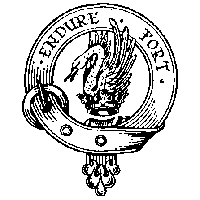
|
Lindsays on the Net Clan Lindsay Discussion Area Clan Lindsay Contacts |

|
Lindsays on the Net Clan Lindsay Discussion Area Clan Lindsay Contacts |

The House of Lindsay established itself in Angus (although Lindsays were to be found throughout Scotland) and engaged in bitter feuds with the Ogilvies and Alexanders. The Lindsays remained loyal throughout to the Stewarts; the 6th Earl died at Flodden in 1513, the 10th supported Mary Queen of Scots and the 16th Earl commanded a regiment for Charles I. When he died the title passed on to a cadet branch, the Balcarres, already raised to earldom of Balcarres in 1651. In 1848, the House of Lords decided that the titles of Earls of Crawford and Earls of Lindsay belonged to James, 7th Earl of Bal carres who was then 24th Earl of Crawford.
The Lindsays are celebrated for their literary talent, Sir David Lindsay of the Mount in Fife, created Lyon King of Arms, was a poet and reformer, and Robert Lindsay of Pitscottie was famed as a witty although unreliable historian.






